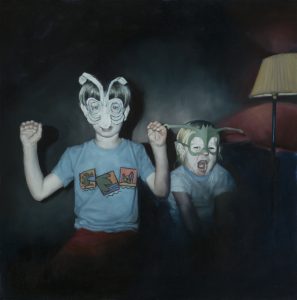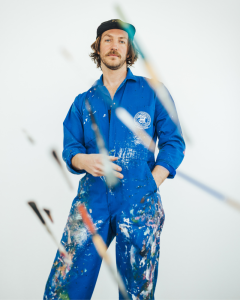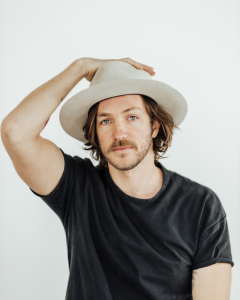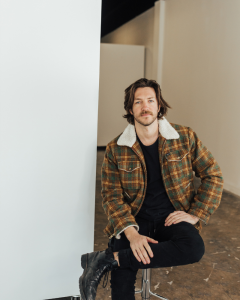A Portrait of the Artist: Jay Wilkinson in His Own Words
Artist Jay Wilkinson is one of the leading lights of the Fort Worth art scene. Wilkinson grew up in and around Fort Worth, both personally and professionally. After years of being what he calls an “outsider artist,” Wilkinson is a Bass Artist in Residence and a gallery owner.

Now, for the first time, Wilkinson sits down with Madeworthy to talk about his art, his past as the enfant terrible of the Fort Worth art scene, and maturing into a mentor and cheerleader for younger artists.
Madeworthy: Tell us about your youth – where did you grow up??

Photo courtesy of Jay Wilkinson
Jay Wilkinson: I grew up in the Mid Cities area. It was a traditional kind of late nineties childhood in the suburbs. My parents divorced when I was nine… we went through some financial struggles, but my mother was always a huge source of imagination and creativity. One time, she used old craft supplies to paint all our faces like the dog, so he felt more comfortable in the family
MW: What made you want to pursue art? Was there an influential teacher who saw your potential?
JW: When I was young, I had an intense case of dyslexia. I wrote backwards and reading was difficult, and I hated doing it. My mother got me comics books because [she hoped] looking at the images would provoke me into reading the captions… Instead, it just made me want to draw everything I saw…
MW: Where did you receive formal training/education? Was there an influential teacher who saw your potential?
JW: I’m mainly self-taught. I briefly attended the Pratt institute in Brooklyn after high school, but didn’t stay… My most important teacher was my high school art teacher, Mr. Floyd. He introduced me to oil painting and saw something in me… he [made me] his teaching assistant so he could work with me one on one, and I had two hours of dedicated work time a day.
MW: Did you have the typical “struggling artist” years? What do you propelled you to become a full-time artist?
JW: After I left college, I didn’t actively paint for almost seven years. I was moving around and trying out different careers and lives. I think I lost confidence for a bit. It happens.
In 2010, I came to Fort Worth after losing a very dear friend in a difficult way, and I found a strange little community of musicians, artists, and weirdos at a little underground music venue on the Southside called The Wherehouse. There I found a whole pile of folks like me… I went a little nuts for a bit, creating giant sculptures, murals, and everything in between on a shoestring budget (which I learned from my mother) for the different parties we would throw… I met Jeremy Joel and Brandon Pederson who would eventually help me create my “train track” art collective, Bobby on Drums. We spent years throwing odd parties and over-the-top installation shows… It wasn’t exactly legal, but it was the world under the world, and that’s where artists live. It was the first time I felt like I was an artist.

photo credit: Angie Garcia
MW: How did you get selected to be a Bass Artist in Residence?
JW: After some wild years of those outsider adventures, we finally made enough noise to be unavoidable, and we met Lauren Childs of Fort Works Art. Not only did she think what we were doing was necessary, she took Jeremy and me on as represented artists. She helped us elevate the work and ourselves professionally… she helped our work be seen nationally in major art fairs around the country. Lauren later introduced me to the Basses through a large-scale sculpture project, and I guess they saw something in me. They have since helped me get my work into spaces and collections I couldn’t imagine on my own. They also gave me an opportunity to open my gallery/studio DANG GOOD CANDY, which allows me to pay forward all the support I have received to upcoming artists.
MW: What have you learned about your collectors? Do you take commissions, and do they influence your work?
JW: I have quite a few very loyal collectors, and I can’t stress how important they are to the life of an artist… they are a source of financial support and also of emotional support.
Being an artist is an entrepreneurial endeavor but at the very far end of the [entrepreneurial] branch where it’s scariest. You’re creating something from a vulnerable place that doesn’t have any inherent utility to itself except beauty (or ugliness) so using a tried-and-true business strategy is impossible, especially if your inner voice isn’t sure you’re good. Many artists are artists because the regular structure of the business world doesn’t come naturally to them. Surviving as a career artist is extremely difficult.
Collectors are people who see you. They see all the toil and sacrifice. They see the love, and they tell you with their support (and their wallets) that you should continue to bring things into the world. That’s a huge vote of confidence, and I highly recommend everyone buy art at any level they can today!
I also do really enjoy commissions they sometimes take you to places you probably wouldn’t normally have gone.
MW: What social issues are reflected in your work? Which ones are you most passionate about?
JW: My work has been traditionally portraiture, and I’ve always been interested in human socialization and memory and how they influence each other. On a large scale, [I’m fascinated] with how we communicate with others, how we communicate with ourselves, how we form identities through relationships, and the way our past relationships affect creating new ones. My solo show from a few years back at Fort Works Art was titled Everyone Poops, which is a funny name inspired by the potty-training book, but it’s also about the concept that when forming strong relationships… there is a 100% certainty that you will one day hurt someone, and they will hurt you. Not necessarily on purpose or irrevocably. It could be small, but it will happen…
MW: Why did you decide to open DANG GOOD CANDY, and how are you spotting new talent?
JW: The name DANG GOOD CANDY comes from an inside joke with my late partner, Jeremy Joel. He died in May 2020, and the gallery is named for and inspired by him. Our relationship started in the wild days, and our mission was to be the strong antiestablishment voice you’d expect from the young, broke, and unseen… As we grew up and progressed… we were always that leveling agent for each other – it’s about the work, don’t get caught in you don’t have.
I guess this is my attempt at being that person that for others. I like to show emerging or mid-career artists who haven’t gotten an opportunity to do a solo exhibition or see a body of their work in one place… [it] really allows them to see the scope and unified message in their work and [become] a stronger artist… these are the artists to purchase before they take off launch into the stratosphere!

photo credit: Angie Garcia
MW: How often do you launch new exhibits/bring in new artists?
JW: We usually do once a month to every six weeks. There are couple other great galleries downtown, (Bale Creek Allen Gallery and Love Texas Art from Artspace 111), and we usually like to time our openings together.
MW: What was the biggest hurdle and learning experience that the pandemic brought you and the art scene in general?
JW: I was living in New York when the pandemic started. I had moved up there a few months before and was working as an installation coordinator for the Armory Show Art Fair when it struck. It was a very intense experience seeing the devastation and the fear of the unknown in a city that large. I think what was difficult for me was that art had always been side by side in my mind with exhibitions, parties, or social events. I’ve always enjoyed the work of creating an experience for an audience, and the lack of that audience forced me to re-tool my understanding of how I went about my art.
MW: On a lighter note, name three up-and-coming artists from Fort Worth we should keep an eye on.
JW: Enrique Nevarez, Sarah Ayala, and Weston Finney.
MW: Congratulations are in order! We hear the big date for your wedding is this summer. Tell us a little about your fiancée.
JW: She’s incredible. She’s a bit private, so I don’t want to say too much but, yeah, she’s my right arm. Being with her is like sleeping when you’re tired. She’s brilliant, intuitive, challenging, and a better artist than I am. I’m happy.
MW: What are you looking forward to most during your New Orleans wedding?
JW: Beignets!
MW: What do you most want to accomplish with your career and life?
JW: This one is tough because I feel like just when I have an idea, my metric for “success” changes. I don’t think there exists a stopping point, and I hope things just get weirder.

photo credit: Angie Garcia
MW: What do you want to be known for?
JW: I don’t know about this one yet either. I hope I haven’t even begun to make the work that will define me. Hopefully, it’s something ridiculous.
MW: What keeps you up at night?
JW: A lot. It’s a big, complicated time, but I’d say art engagement. There’s a problem between patrons or private business in understanding the value of what we do. Like I said before, it’s tough being an artist, and I know it can be tough working with an artist. Communication isn’t always our strong suit.
If you do choose to commission or work with an artist on a project, remember [the artist has] mastered a skill. Somewhat like a plumber or an electrician, it takes countless hours for proficiency, and sometimes it can even be dangerous. Artists should always be paid as such. I know that so many artists love to create and would gladly do it for free or even at a cost to themselves, but at every level, they deserve compensation for their skill… Help them continue making things more interesting for all of us.
MW: Have you or will you create NFTs [non-fungible tokens]? What do you think about this new medium?
JW: I haven’t yet tried it, but I have many friends who have… I love the concept that there is a trackable strategy for “royalties” in art. It sounds promising, but I don’t know enough yet. I could use some help with it.

photo credit: Angie Garcia
Quick Study, aka The Lightning Round
MW: Where do you go to get inspired?
JW: I really enjoy walking around the railroad tracks. It’s quiet and industrial and old. Love it.
MW: Where do you go to unwind?
JW: I’m a big outside guy. I hate the winter. I recently got into paddle boarding – I’m a big fan.
MW: Best cocktail or bar in Fort Worth?
JW: I’m partial to Tarantula Tiki Bar; it’s next to [DANG GOOD CANDY]… every drink is titled like a Don Henley song.
MW: Favorite place to listen to live music?
JW: Tulips FTW is great. Great room and they have a great booker.
MW: Are you an early bird or night owl?
JW: Early now [that] I’m 36. I tried to convince my fiancée to call it at 9 o’clock last night!
MW: One place you hope never goes out of business?
JW: Jazz Cafe on Montgomery. Best black beans I’ve ever had.
MW: Biggest pet peeve?
JW: Slow walkers.
MW: Favorite weekend destination?
JW: There’s an amateur wrestling league in Bedford you’ve got to see to believe.
MW: International locale you dream to visit?
JW: Spain – someone just recommended Costa Brava to me today. Honeymoon?
MW: Most coveted art piece in your collection?
JW: I have a portrait I did of a friend who passed away that Jeremy [Joel] collaborated on before he passed, so its two of my pals who are gone together. It means everything to me.
MW: Who would you like to collaborate with?
JW: My pal and great artist Erik Inkala – look him up, it’s great stuff!
MW: Favorite yearly event in Fort Worth?
JW: ArtsGoggle is great.


 Sign in
Sign in

